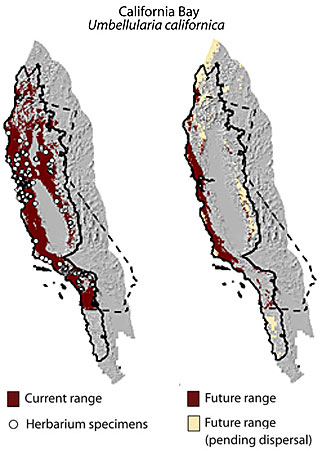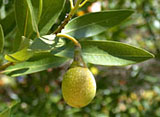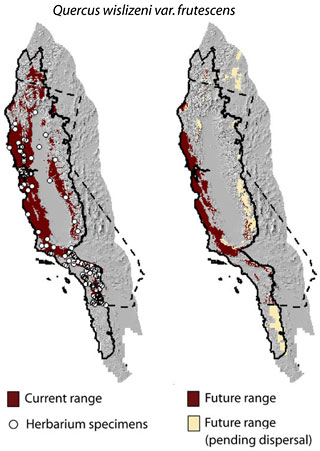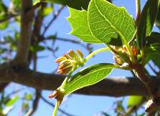UC Berkeley Press Release
Climate change could severely impact California's endemic plants
BERKELEY – The native plants unique to California are so vulnerable to global climate change that two-thirds of these "endemics" could suffer more than an 80 percent reduction in geographic range by the end of the century, according to a new University of California, Berkeley, study.
Because endemic species - native species not found outside the state - make up nearly half of all California's native plants, a changing climate will have a major impact on the state's unparalleled plant diversity, the researchers warn.
  Photo © 2001 Tony Morosco Photo © 2001 Tony Morosco |
The researchers caution that their study can't reliably predict the fate of specific species. However, the trend is clear: The researchers project that, in response to rising temperatures and altered rainfall, many plants could move northward and toward the coast, following the shifts in their preferred climate, while others, primarily in the southern part of the state and in Baja California, may move up mountains into cool but highly vulnerable refugia
Coast redwoods may range farther north, for example, while California oaks could disappear from central California in favor of cooler weather in the Klamath Mountains along the California-Oregon border. Many plants may no longer be able to survive in the northern Sierra Nevada or in the Los Angeles basin, while plants of northern Baja California will migrate north into the San Diego mountains. The Central Valley will become preferred habitat for plants of the Sonoran desert.
"Across the flora, there will be winners and losers," said first author Scott Loarie, a Ph.D. candidate at Duke University's Nicholas School for the Environment who has worked with Ackerly on the analysis for the past four years. "In nearly every scenario we explored, biodiversity suffers - especially if the flora can't disperse fast enough to keep pace with climate change."
The authors identified several "climate-change refugia" scattered around the state. These are places where large numbers of the plants hit the hardest by climate change are projected to relocate and hang on. Many of these refugia are in the foothills of coastal mountains such as the Santa Lucia Mountains along California's Central Coast, the Transverse Ranges separating the Central Valley from Los Angeles and the San Gabriel Mountains east of Los Angeles. Many of these areas are already under increasing pressure from encroaching suburban development.
"There's a real potential for sheltering a large portion of the flora in these refugia if they are kept wild and if plants can reach them in time," Loarie said. The authors argue that it's not too early to prepare for this eventuality by protecting corridors through which plants can move to such refugia, and maybe even assisting plants in reestablishing themselves in new regions.
"Part of me can't believe that California's flora will collapse over a period of 100 years," Ackerly said. "It's hard to comprehend the potential impacts of climate change. We haven't seen such drastic changes in the last 200 years of human history, since we have been cataloguing species."
Ackerly, Loarie and colleagues at UC Berkeley, Duke University in Durham, N.C., California Polytechnic State University (Cal Poly) in San Luis Obispo and Texas Tech University in Lubbock report their findings in the open-access journal PLoS ONE, which appears online June 25.
  Photo © Michael Charters Photo © Michael Charters |
In collaboration with climate modeler Katharine Hayhoe of Texas Tech, Loarie and Ackerly then employed two different climate models - one based at the U.S. National Center for Atmospheric Research and the other at the United Kingdom Meteorological Office - that predict changes in temperature and precipitation through the year 2100 for lower and higher greenhouse gas emissions scenarios. They then projected for each model and scenario where California's endemic species would have to move in order to find the microclimate they need to survive. One set of projections assumed that plants can easily relocate, while another assumed that they cannot migrate at all by 2100, so their ranges will only shrink as climate changes.
Loarie emphasized that there are many uncertainties in the analysis - for example, in the known range of individual plants; in knowledge of the microclimate each plant prefers; in how much warming can be expected based on best- and worst-case greenhouse gas scenarios; in the direction and magnitude of changes in California rainfall; and in whether or not plants can migrate sufficiently in 100 years to discover congenial habitat.
Despite these unknowns, the researchers said they are confident in their approach, which has been used previously to predict global warming's effects on isolated species or plant families in places such as South Africa, Europe, the eastern U.S. and southern California.
"We can have confidence in the trends, if not in what happens to specific species," Loarie said. "There is a clear trend despite the uncertainty."
In the most optimistic scenario, in which global emissions of carbon dioxide return to near-1990 levels by the end of the century and plants are able to move into new habitats within a century, diversity of species in parts of California might actually increase, especially along the northwest and central coast. Nevertheless, diversity in the northern Sierra and in southern California would decrease.
However, such an optimistic outcome is far less likely than more dire ones, Ackerly said. In the higher scenario - the greatest warming, and plants unable to move in the 90- to-100-year time frame of global warming - plant diversity will decrease everywhere by as much as 25 percent, even if no species actually become extinct. Similarly, 66 percent of all endemic species will experience more than an 80 percent reduction in range.
If plants are able to disperse in time to find more suitable habitat, the researchers found that ranges will shift by an average of 150 kilometers (95 miles) under higher climate change, often with no overlap between the old and new ranges. Paradoxically, this may separate species that now live together: Substantial numbers of floral communities may be split up as some species move south and uphill while others move north and towards the coast.
Though the study did not look at the response of invasive or non-native plants to climate change, Ackerly said that they likely will expand their ranges at the expense of natives and endemics. And shifting and shrinking ranges of endemic species likely will affect animal diversity as well. Ackerly noted that range change may separate an animal from its major food source, or a pollinator from its preferred plant.
With the shifting ranges of endemic species, species conservation becomes a moving target, the researchers noted. Brent Mishler, director of the University and Jepson herberia and a professor of integrative biology, anticipates a big need for information on possible plant movement among those people protecting, managing or restoring natural areas around the state.
"They could really benefit by knowing what plants are in danger of being eliminated from their area, and maybe even more importantly, what plants to keep in mind that will be 'refugees' from other sites that will need to move into their area to avoid extinction," he said. "Planning for refugees will become a new but important concept for natural reserves to think about."
Coauthors with Loarie, Ackerly and Hayhoe are UC Berkeley graduate student Benjamin E. Carter; database specialist Richard Moe of UC Berkeley's University and Jepson herbaria; professor Charles A. Knight of Cal Poly; and statistician Sean McMahon of Duke. Loarie, who began the research project with Ackerly while working on his B.S. at Stanford University, continued the project while earning his Ph.D. at Duke, and will be starting a post-doctoral fellowship at the Carnegie Institute of Washington's Department of Global Ecology this summer.

